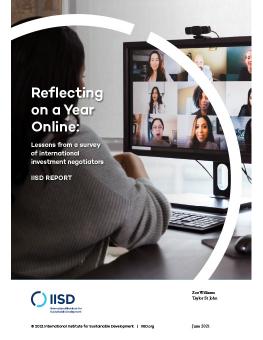
Reflecting on a Year Online: Lessons from a survey of international investment negotiators
This report examines the opportunities, challenges, and consequences of virtual negotiations based on an analysis of a survey of officials participating in two investment negotiations that moved to virtual sessions due to COVID-19.
How do you negotiate online? In early 2020, officials and governments found themselves facing this question as the coronavirus pandemic led to in-person negotiations being paused indefinitely. For the first time, large global talks hosted by multilateral organizations moved online. Virtual negotiations were a necessity given the circumstances. The move online was framed as a short-term substitute to keep these processes moving during the pandemic. Yet, virtual negotiations may endure long past the pandemic, given the climate emergency and longer-term trends toward more virtual meetings and heavier reliance on digital technologies.
Whether they are temporary or permanent, it is important to examine the opportunities, challenges, and consequences of virtual negotiations—such as what these mean for informal interactions, coalition building, participation and inclusiveness, costs, and climate impact.
This report explores these issues, based on an analysis of a survey of officials participating in two negotiations in investment that made the move to virtual sessions: the United Nations Commission on International Trade Law (UNCITRAL) Working Group III on investor–state dispute settlement (ISDS) reform and the Joint Statement Initiative (JSI) on investment facilitation, held among a group of members of the World Trade Organization (WTO). The authors conclude their analysis with thoughts for the future, reviewing how survey respondents hope to see negotiations evolve, along with the authors' own suggestions for how virtual negotiations could be improved.
You might also be interested in
A Balancing Act
With Nigeria's growing population in need of wide-ranging solutions to the multidimensional poverty it faces, a new IISD report outlines how the LNG dash could ultimately leave the economy more vulnerable to external shocks and without a solid domestic foundation.
Border Carbon Adjustments: Trinidad and Tobago country report
This report consolidates, analyzes, and presents views and perspectives of stakeholders from Trinidad and Tobago on border carbon adjustment (BCA) schemes to contribute to the global debate on BCA good practices.
Global Dialogue on Border Carbon Adjustments: The case of Brazil
This report consolidates, analyzes, and presents the views and perspectives of stakeholders from Brazil on border carbon adjustment (BCA) schemes to contribute to the global debate on BCA good practices.
Ecuador Referendum Rules Out ISDS Return, Underlining Public Support for a Sustainable Path
Ecuador has voted to allow international arbitration and investor–state dispute settlement (ISDS) in its treaties and agreements. But the risks that initially made them turn away from this outdated model remain.